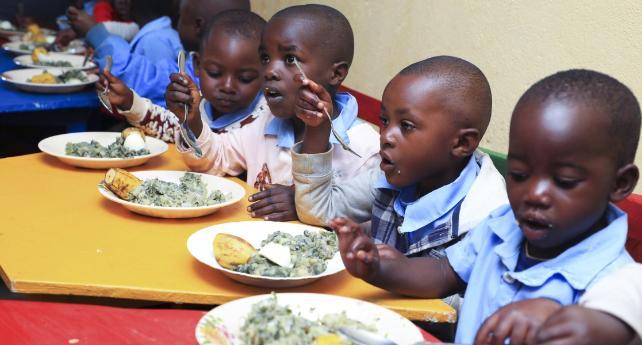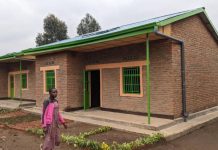Africa-Press – Rwanda. Rwanda has made progress in reducing multidimensional poverty among children, with a decline registered across multiple wellbeing dimensions over the last seven years, according to a new report.
According to a study by the National Institute of Statistics of Rwanda (NISR), multidimensional child poverty analysis for Rwanda encompasses five dimensions of wellbeing, namely health, education, water, sanitation and housing. These dimensions are further disaggregated by key backgrounds such as province, sex, household head’s education level and family composition.
A child is considered multidimensionally poor when they concurrently experience deprivation in at least three of the five dimensions of wellbeing.
According to the NISR’s latest multidimensional child poverty thematic report released on July 7, the rate of children aged 5 to 14 living in multidimensional poverty has more than halved from 25.3 per cent in 2016/17 to 11.9 per cent in 2023/24.
The multidimensional child poverty analysis, which focuses on focused on children aged 5 to 14 and 15 to 17, used data from the seventh Integrated Household Living Conditions Survey EICV7, whose findings were released in April.
A similar trend was observed among children aged 15 to 17, with multidimensional poverty declining from 40.1 per cent to 26.8 per cent over the same period, which indicates a decrease of 13.3 percentage points.
Between 2017 and 2024, Rwanda reduced the poverty rate from 39.8 per cent to 27.4 per cent, according to the statistics office.
As per the thematic report, the progress achieved during the period under review was driven by improved access to basic services such as education, health, sanitation, housing, and clean water.
It showed that the improvement was measured using the United Nations Children’s Fund (UNICEF) Multiple Overlapping Deprivation Analysis (MODA) framework. Unlike traditional poverty assessments based on income, MODA identifies overlapping deprivations that directly impact children’s well-being and future development to accurately address the needs of children.
While the results align with existing studies of monetary poverty, showing that children living in financially unstable households experience multiple deprivations, the MODA analysis reveals “significant” deprivations persisting even among children living in better-off households.
By addressing both monetary and non-monetary aspects of child poverty, Rwanda is aligning its efforts with the UN Sustainable Development Goals (SDGs), its Vision 2050, and the National Strategy for Transformation (NST2), the statistics office observed.
The report indicated that assessing the current challenges from the perspective of the child’s wellbeing provides important insights on the nature of poverty in Rwanda, specifically to know who the poor are, why their poverty persists, and how poverty is transmitted across generations.
Key highlights
In 2023/24, the highest deprivation rates among children aged 5-14 years were observed in three indicators, which are a household’s waste disposal, distance to water source, and lighting source.
Notably, the survey showed that 38.4 per cent of children within this age bracket live in a household that inadequately disposes rubbish/garbage.
Still, more than one in three children (36.7 per cent) is deprived in terms of distance to a water source, while 27.1 per cent live in households relying on an unimproved lighting source.
On the contrary, the lowest deprivation rate are observed in school attendance (4.1 per cent) in the education dimension, toilet type (5.2 per cent) for the sanitation dimension, distance to a health facility (8.2 per cent) for health dimension, and improved water source (11.6 per cent) in the water dimension.
For children aged 15 to 17 years, the highest deprivation rate is found for the school attendance indicator (48 per cent), distance to water source (35.2 per cent), and garbage disposal (34.8 per cent). Whereas the lowest deprivations relate to toilet type (5.1 per cent) in the sanitation dimension, distance to a health facility (8.3 per cent) in the health dimension, and improved water source (10.8 per cent) in the water dimension.
Higher rates in rural areas, female-headed households
Multidimensional poverty remains concentrated in rural areas and certain provinces, with higher deprivation rates observed in the Southern, Eastern and Western provinces, the survey pointed out.
It is also more prominent in female-headed households (facing at least three deprivations) across both age groups. Similarly, the absence of a male-headed household is associated with higher multidimensional child poverty, it indicated.
Meanwhile, it observed that multidimensional child poverty is lower in households with higher education attainment of the household head.
Recommendations for greater gains
Based on the comprehensive findings outlined in the report, the study made a number of policy recommendations to address multidimensional child poverty in Rwanda.
The report indicated that, with a young population and the opportunity to benefit from accelerated economic growth from this demographic dividend, Rwanda can further prioritise children by ensuring that they have access to all their basic needs and services and that their rights are protected.
It warned that multiple and overlapping deprivations during childhood and adolescence can have irreversible effects on the eventual productivity and social inclusion of children.
Putting in place policies, including social protection packages to reduce children’s deprivation, is the best way to break the cycle of inter-generational poverty, it stated.
Alleviating the intensity and severity of deprivation among children will contribute significantly to Rwanda’s future economic growth and overall productivity.
For More News And Analysis About Rwanda Follow Africa-Press






